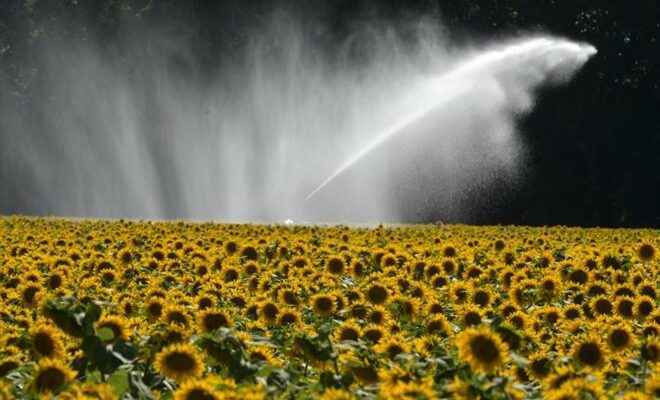In New Aquitaine, charred sunflowers and worried farmers (AFP/Archives/Iroz Gaizka)
In the hands of Christian Daniau, the flower head – the head of the sunflower – barely exceeds 15 cm in diameter and its leaves have turned the colors of ash: the plant is thirsty and this Charente farmer is “worried”.
Star of spring with a sharp increase in cultivated area, French sunflowers were partly charred by the historic drought this summer.
On the national 10 which crosses the Charente from north to south, follow one another fields of sunflowers browned by the sun, the head of the plant leaning towards the ground.
In the driest areas, the harvest should start around August 15, “three weeks in advance”, warns Mr. Daniau, also president of the local Chamber of Agriculture.
In the department, the last rain dates back to June 20, recalls this farmer who will be able to “save his harvest” thanks to “three waterings” in two months, each time with 35 mm of water pumped from the nearby Bonnieure river.
But even in the irrigated plots, all the plants located at the edge of the fields, less watered, were burned. In this shallow soil with a rocky subsoil, these stems return 40 cm to their watered neighbours. They will give three times less seeds.
Less well off because subject to severe restrictions on water withdrawals, in Deux-Sèvres, “98% of the plots have not been irrigated”, estimates François Chauvaud, of the Chamber of Agriculture.

Even in the irrigated plots, all the plants located on the edge of the fields, less watered, were burned (AFP / Archives / Jean-François MONIER)
“It’s a disaster”, repeats three times in a row this farmer who expects “yields of -50% or even -80%” on his 80 hectares of “scorched” sunflowers, for lack of water available in the dam which fed.
If it is “too early” to decide on a national scale according to the Avril group, the French number one in vegetable oils, the ministry foresees, in a note of August 5, a 2022 harvest similar to that of last year. , despite “a sharp increase” (+20.6%) in cultivated areas.
– “We will have wastelands” –
Because four months earlier, at the beginning of spring, the sunflower had everything to please.
It requires little fertilizer when the price of nitrogen was close to highs, requires three times less water than corn or soybeans in the summer when a dry season was looming and was much sought after after the outbreak of the conflict in Ukraine – the world’s largest exporter.
The plant, rich in protein, intended half for human consumption – in oil – and the other half for livestock – once transformed into meal – was sown on 842,000 hectares, a level not reached since the 1990s.
For Mr. Daunia, its culture is a tool of “sovereignty” allowing “to reduce our imports of soybeans” and which remains “adapted” to the French climate, despite more frequent droughts in the future with climate change.
He, like his union the FNSEA, are demanding the creation of reserves to “store” water during the winter in order to irrigate in the summer. “If we don’t, we will have wastelands,” warns Mr. Chauvaud.
These projects of water retention works arouse local opposition, their detractors considering that they constitute a “privatization of water”.
But for Mr. Daniau, without water, in the “light lands” of northern New Aquitaine, “if even the sunflower does not grow, nothing grows”.
© 2022 AFP
Did you like this article ? Share it with your friends with the buttons below.




